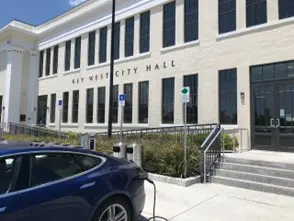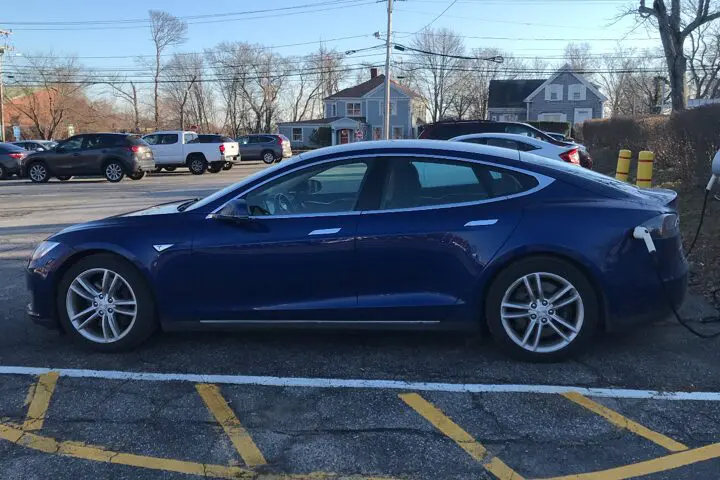Zero Emissions to Mile Zero
Growing up the son of a classic car enthusiast, I would often hear tales and vagaries of the “Great American Road Trip.” I would picture our own family zig-zagging across the country in one of the cars my father restored—a turquoise Ford Thunderbird, a coral Chevy Nomad, or even my personal favorite, his black and red 1958 Edsel with the revolutionary Teletouch automatic transmission. So, it should come as little surprise that in the ensuing decades I have lived out those dreams—driving up and down the Pacific Coast Highway, exploring family history in Quebec, and meandering through the Great Smoky Mountains. But my latest trip was something I could never have imagined as a young child staring at the Edsel’s unique horse collar grill. Because my latest road trip was…all- electric!
 A few years ago, I had the chance to buy a used 2015 Tesla Model S 70 with approximately 236 miles of range for significantly less than even the pre-pandemic prices of most battery electric vehicles (EVs) on the market today. It was an outlier deal then—a “steal” really—and has only improved with age. And because early Tesla models included unlimited complimentary “Supercharging” at the company’s international, proprietary network of fast Level 3 charging stations, I was inspired to start plotting a new generation of road trips. I started with some proving trips around the region—to friends in New Jersey and Maryland; through Mohawk Trail and to the top of Mount Washington; and to a wedding in rural upstate New York. But as the pandemic took its toll, my wanderlust grew exponentially. I soon started planning a longer challenge that would take me to the end of U.S. Route 1 in Key West, Florida.
A few years ago, I had the chance to buy a used 2015 Tesla Model S 70 with approximately 236 miles of range for significantly less than even the pre-pandemic prices of most battery electric vehicles (EVs) on the market today. It was an outlier deal then—a “steal” really—and has only improved with age. And because early Tesla models included unlimited complimentary “Supercharging” at the company’s international, proprietary network of fast Level 3 charging stations, I was inspired to start plotting a new generation of road trips. I started with some proving trips around the region—to friends in New Jersey and Maryland; through Mohawk Trail and to the top of Mount Washington; and to a wedding in rural upstate New York. But as the pandemic took its toll, my wanderlust grew exponentially. I soon started planning a longer challenge that would take me to the end of U.S. Route 1 in Key West, Florida.
Lots of people talk about having range anxiety. I quickly eliminated any marginal concerns through my early proving trips. But ahead of this journey, I did have what I will call range “curiosity.” I wondered whether the projected battery range would hold up under actual driving conditions, especially as temperatures and speed limits would increase significantly as I navigated further south. Would the weight of passengers and luggage cut noticeably into efficiency? Would there be enough chargers around to facilitate diversions from the main path? Would the charging stops become more onerous as the trip wore on? And despite over $4.30 per gallon gasoline, would I conclude it would have been more practical to drive a gas-powered vehicle for this trip?
To make a long story short, I continue to find both short and long trips far more pleasant in my electric vehicle than any gas powered vehicle I’ve driven, and I would be very happy to never drive a gas-powered vehicle again.
The Journey
 My first stop was a reunion at my college roommate’s apartment in New Jersey where I plugged into a Level 2 charger overnight. With a full battery, I drove the nearly 200 miles south that morning to rendezvous with a friend at the Hanover, Maryland, Supercharging station—he was carrying out the time-honored tradition of driving his mother’s vehicle back north from Florida for the summer. We grabbed lunch and coffee and soon were back on our respective missions. He recommended a route south which would take me across the Potomac through eastern Maryland and bypass much of the weekend traffic surrounding the Capital Beltway. Thanks to this impromptu diversion, I stumbled onto an antique shop in Port Royal, Virginia, nearly purchasing the stone sasquatch prominently displayed outside—maybe on the way back!
My first stop was a reunion at my college roommate’s apartment in New Jersey where I plugged into a Level 2 charger overnight. With a full battery, I drove the nearly 200 miles south that morning to rendezvous with a friend at the Hanover, Maryland, Supercharging station—he was carrying out the time-honored tradition of driving his mother’s vehicle back north from Florida for the summer. We grabbed lunch and coffee and soon were back on our respective missions. He recommended a route south which would take me across the Potomac through eastern Maryland and bypass much of the weekend traffic surrounding the Capital Beltway. Thanks to this impromptu diversion, I stumbled onto an antique shop in Port Royal, Virginia, nearly purchasing the stone sasquatch prominently displayed outside—maybe on the way back!
From Port Royal, I made great time through Virginia and the Carolinas and into Georgia, pulling off to explore here and there and eventually stopping for the night at a hotel with its own bank of Superchargers.
Well rested and fully charged, I set my sights on South Florida to pick up family flying in for the week. I finally encountered my first problem of the trip—I was unexpectedly ahead of schedule. I thought I’d hit more traffic…I thought charging stops would take more time…I thought I would need an extra day to comfortably arrive on time in Miami. So, I started researching destinations not on my original itinerary—would there be a rocket launch from Cape Canaveral? Concerts? Sports? As it turns out, the NHL’s Tampa Bay Lightning were hosting a playoff game and outdoor viewing party on the plaza right outside their arena. After a quick check of hotels in the area, I found one within walking distance of the arena that also offered complimentary Level 2 charging—ideal for an overnight stay. So, onto Tampa and what turned out to be a fantastic and lively party complete with music, lawn games, food, and perfect weather!

In the morning, I was back on the road, driving south and then turning east across “Alligator Alley.” About halfway across this long stretch of isolated highway partitioning both the Big Cypress National Reserve and Florida Everglades, I stopped at the Supercharger on the Miccosukee Reservation and watched the sun rise with a couple charging their car to make the reverse trip up to Tampa and eventually back to Michigan. After sidestepping the largest crickets I’ve ever seen, I was back on the road to South Florida where my family would soon land. We spent the night in Miami Beach where the local parking garage had multiple Level 2 chargers to use for a fee.
The next morning, we all piled into the car, cruised slowly south on Ocean Avenue between South Beach on our left and rows of iconic Art Deco buildings on our right, and then continuing onto the Florida Keys.
 We stopped at one of our favorite lunch spots in Islamorada which also included a Level 2 charger—we didn’t necessarily need to charge but adding about 30 miles of range while we ate lunch gave us enough of a buffer to confidently make it all the way to Key West. The next morning, I drove to Key West City Hall to use their level 2 charger, retrieving it later in the day with nearly a full charge. For the rest of the stay, I kept the car plugged into an outdoor outlet—nothing fancy, just a standard 120-volt outlet to maintain a full charge. We drove back to New England mostly with the windows down, soaking up all of the heat we could, and stopping at a nearly entirely different set of charging stations along the way.
We stopped at one of our favorite lunch spots in Islamorada which also included a Level 2 charger—we didn’t necessarily need to charge but adding about 30 miles of range while we ate lunch gave us enough of a buffer to confidently make it all the way to Key West. The next morning, I drove to Key West City Hall to use their level 2 charger, retrieving it later in the day with nearly a full charge. For the rest of the stay, I kept the car plugged into an outdoor outlet—nothing fancy, just a standard 120-volt outlet to maintain a full charge. We drove back to New England mostly with the windows down, soaking up all of the heat we could, and stopping at a nearly entirely different set of charging stations along the way.
Next up, the other end of Route 1 in Maine! If I found a sasquatch statute in Virginia—what will I find up there?
Ruminations from the Road
- Drivers still need incentives to make the switch to zero-emissions vehicles and manufacturers need to solve supply chain woes in order to bring down the cost and build-times of all lower-polluting vehicles. Federal and state tax credits and/or rebates, when designed equitably, can help more people afford EVs which typically carry a higher up-front cost offset over time by lower fueling and maintenance costs. Acadia Center has repeatedly supported expanding EV incentives to used vehicles, lowering the sales price cap for EV incentives, and expanding eligibility to E-bikes. This package of reforms help ensure incentives are helping people that need assistance making the transition rather than subsidizing new vehicles for wealthier individuals that likely don’t require the credit or rebate.
- This trip would likely not have been as easy without access to Tesla’s well-developed proprietary network of fast chargers—this is a complaint I have heard from some of my fellow electric vehicle drivers. I could quickly locate chargers along my route using the built-in navigation system and could always access multiple charging destinations without concern. It will be critical to expand EV charging networks to fully unlock the transformative potential of electric vehicles, including personal, commercial, public transit, and medium– and heavy–duty vehicles. Last year’s federal Infrastructure Investment and Jobs Act (IIJA) included funding to expand the nation’s EV charging network and states are in the process of developing their IIJA plans this summer. My trip demonstrated more hotels could benefit from offering and advertising EV charging amenities on highway billboards to attract wandering travelers looking to recharge body, mind, and car overnight.
- I found stopping every few hours to charge quite refreshing. On all of my past gas-powered road trips, there was always self-imposed pressure to fuel up and get back out as quickly as possible. Since my car has older charging technology, my stops would sometimes take about 30 minutes—the perfect amount of time to use the restroom, maybe grab a bite, stretch my legs, check email, and even go for a light jog or walk. At the same time, as batteries and charging technology continue to improve by leaps and bounds, the number of stops and time to “refill” will continue to decrease. In fact, the 2022 version of my vehicle already has nearly double the range and is able to charge at much higher speeds to make the experience more comparable to stopping for gas. All drivers should consider their wellness on any long drive and build in time to take these breaks even if their vehicles don’t require them as much in the future. Maybe I’m also just choosing better priorities as I get older…
- Electric vehicles are clearly not the only component to a clean transportation transition. Along my journey, I saw wonderful pedestrian and bicycle infrastructure, United States Postal Service cargo bicycles, scooter and bike shares, dedicated bus lanes and free transit shuttles, water taxis, and more. We need comprehensive approaches to provide clean transportation options for all users.
- While EVs have zero emissions from the tailpipe, there are still associated emissions from electricity generation and of course the initial manufacturing. It is critical we address all of the life cycle and associated emissions by shifting electrical generation to increasingly rely upon renewables like wind, solar, and energy storage. Similarly, the manufacture of all vehicles, including EVs, needs to pivot rapidly to eliminate extractive and abusive practices and much more must be done to mitigate environmental impacts of mining and manufacturing. At the same time, those raising concerns about the manufacture of EVs should do so in good faith and recognize the long-established and ongoing impacts implicit in the extraction and manufacture of fossil fuels and fossil fuel burning vehicles.
- Finally, no Acadia Center story is complete without data! My total round trip was 3,636.5 miles. I used 1,084.9 kilowatt hours (kWh) for an average of 3.35 miles per kWh or, correspondingly, about 298-Watt hours per mile (Wh/mile). In typical driving conditions, my overall consumption is between 225 and 250 Wh/mile, and I can reasonably theorize the decreased efficiency on this trip was due to a few factors, including:
- Higher sustained speeds from southern Virginia through most of Florida due to lower highway congestion and higher posted speed limits;
- Increased use of air conditioning from South Carolina through Florida;
- Combined weight of passengers and luggage that ranged from 500-1000 pounds throughout the trip;
- Driving with the windows down for approximately 1500 miles of the 3,636.5–mile journey;
- Assuming I used a gas-powered hybrid achieving 30 miles per gallon at that week’s East Coast retail average price of $4.33 per gallon, I would have consumed approximately 121 gallons of fuel at a cost of $524. Comparatively, I would have spent approximately $325 on electric charging assuming an average per kWh cost of $0.30—a conservatively higher price for electricity to account for Tesla Supercharging and Blink fees as well as any applicable demand charges or other possible rate structures utilized across the states where I charged. This comparison is illustrative only and admittedly imprecise because of the widespread availability of complimentary electric vehicle charging as a customer amenity.
For more information:
Hank Webster, Rhode Island Director & Senior Policy Advocate, hwebster@acadiacenter.org, 401.276.0600 ext.402



















